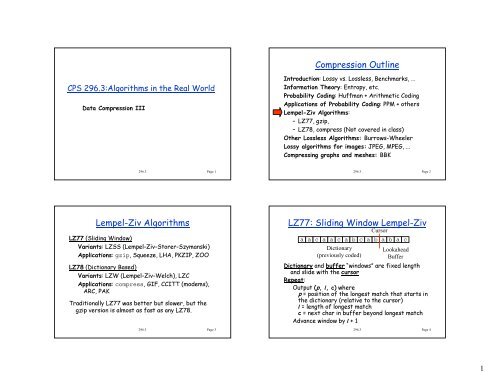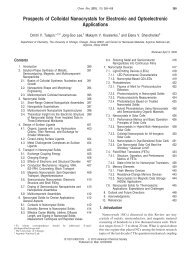Compression Outline Lempel-Ziv Algorithms LZ77: Sliding Window ...
Compression Outline Lempel-Ziv Algorithms LZ77: Sliding Window ...
Compression Outline Lempel-Ziv Algorithms LZ77: Sliding Window ...
You also want an ePaper? Increase the reach of your titles
YUMPU automatically turns print PDFs into web optimized ePapers that Google loves.
CPS 296.3:<strong>Algorithms</strong> in the Real World<br />
Data <strong>Compression</strong> III<br />
296.3 Page 1<br />
<strong>Lempel</strong>-<strong>Ziv</strong> <strong>Algorithms</strong><br />
<strong>LZ77</strong> (<strong>Sliding</strong> <strong>Window</strong>)<br />
Variants: LZSS (<strong>Lempel</strong>-<strong>Ziv</strong>-Storer-Szymanski)<br />
Applications: gzip, Squeeze, LHA, PKZIP, ZOO<br />
LZ78 (Dictionary Based)<br />
Variants: LZW (<strong>Lempel</strong>-<strong>Ziv</strong>-Welch), LZC<br />
Applications: compress, GIF, CCITT (modems),<br />
ARC, PAK<br />
Traditionally <strong>LZ77</strong> was better but slower, but the<br />
gzip version is almost as fast as any LZ78.<br />
296.3 Page 3<br />
<strong>Compression</strong> <strong>Outline</strong><br />
Introduction: Lossy vs. Lossless, Benchmarks, …<br />
Information Theory: Entropy, etc.<br />
Probability Coding: Huffman + Arithmetic Coding<br />
Applications of Probability Coding: PPM + others<br />
<strong>Lempel</strong>-<strong>Ziv</strong> <strong>Algorithms</strong>:<br />
– <strong>LZ77</strong>, gzip,<br />
– LZ78, compress (Not covered in class)<br />
Other Lossless <strong>Algorithms</strong>: Burrows-Wheeler<br />
Lossy algorithms for images: JPEG, MPEG, ...<br />
Compressing graphs and meshes: BBK<br />
296.3 Page 2<br />
<strong>LZ77</strong>: <strong>Sliding</strong> <strong>Window</strong> <strong>Lempel</strong>-<strong>Ziv</strong><br />
a a c a a c a b c a b a b a c<br />
Dictionary<br />
(previously coded)<br />
Cursor<br />
Lookahead<br />
Buffer<br />
Dictionary and buffer “windows” are fixed length<br />
and slide with the cursor<br />
Repeat:<br />
Output (p, l, c) where<br />
p = position of the longest match that starts in<br />
the dictionary (relative to the cursor)<br />
l = length of longest match<br />
c = next char in buffer beyond longest match<br />
Advance window by l + 1<br />
296.3 Page 4<br />
1
<strong>LZ77</strong>: Example<br />
a a c a a c a b c a b a a a c (_,0,a)<br />
a a c a a c a b c a b a a a c (1,1,c)<br />
a a c a a c a b c a b a a a c (3,4,b)<br />
a a c a a c a b c a b a a a c (3,3,a)<br />
a a c a a c a b c a b a a a c (1,2,c)<br />
Dictionary (size = 6) Longest match<br />
Buffer (size = 4)<br />
Next character<br />
296.3 Page 5<br />
<strong>LZ77</strong> Optimizations used by gzip<br />
LZSS: Output one of the following two formats<br />
(0, position, length) or (1,char)<br />
Uses the second format if length < 3.<br />
a a c a a c a b c a b a a a c (1,a)<br />
a a c a a c a b c a b a a a c (1,a)<br />
a a c a a c a b c a b a a a c (1,c)<br />
a a c a a c a b c a b a a a c (0,3,4)<br />
296.3 Page 7<br />
<strong>LZ77</strong> Decoding<br />
Decoder keeps same dictionary window as encoder.<br />
For each message it looks it up in the dictionary and<br />
inserts a copy at the end of the string<br />
What if l > p? (only part of the message is in the<br />
dictionary.)<br />
E.g. dict = abcd, codeword = (2,9,e)<br />
• Simply copy from left to right<br />
for (i = 0; i < length; i++)<br />
out[cursor+i] = out[cursor-offset+i]<br />
• Out = abcdcdcdcdcdce<br />
296.3 Page 6<br />
Optimizations used by gzip (cont.)<br />
1. Huffman code the positions, lengths and chars<br />
2. Non greedy: possibly use shorter match so that<br />
next match is better<br />
3. Use a hash table to store the dictionary.<br />
– Hash keys are all strings of length 3 in the<br />
dictionary window.<br />
– Find the longest match within the correct<br />
hash bucket.<br />
– Puts a limit on the length of the search within<br />
a bucket.<br />
– Within each bucket store in order of position<br />
296.3 Page 8<br />
2
The Hash Table<br />
7 8 9 101112131415161718192021<br />
… …<br />
…<br />
a a c a a c a b c a b a a a c<br />
a a c 19<br />
a a c 10<br />
c a b 15<br />
c a b 12<br />
a c a 11<br />
c a a 9<br />
a a c 7 a c a 8<br />
296.3 Page 9<br />
Comparison to <strong>Lempel</strong>-<strong>Ziv</strong> 78<br />
Both <strong>LZ77</strong> and LZ78 and their variants keep a<br />
“dictionary” of recent strings that have been seen.<br />
The differences are:<br />
– How the dictionary is stored (LZ78 is a trie)<br />
– How it is extended (LZ78 only extends an existing<br />
entry by one character)<br />
– How it is indexed (LZ78 indexes the nodes of the<br />
trie)<br />
– How elements are removed<br />
296.3 Page 11<br />
…<br />
…<br />
Theory behind <strong>LZ77</strong><br />
The <strong>Sliding</strong> <strong>Window</strong> <strong>Lempel</strong>-<strong>Ziv</strong> Algorithm is Asymptotically Optimal,<br />
A. D. Wyner and J. <strong>Ziv</strong>, Proceedings of the IEEE, Vol. 82. No. 6,<br />
June 1994.<br />
Will compress long enough strings to the source entropy as the window<br />
size goes to infinity.<br />
Source entropy for a substring of length n is given by:<br />
H<br />
n<br />
=<br />
∑n X∈A<br />
1<br />
p(<br />
X ) log<br />
p(<br />
X )<br />
Uses logarithmic code (e.g. gamma) for the position.<br />
Problem: “long enough” is really really long.<br />
296.3 Page 10<br />
<strong>Lempel</strong>-<strong>Ziv</strong> <strong>Algorithms</strong> Summary<br />
Adapts well to changes in the file (e.g. a Tar file with<br />
many file types within it).<br />
Initial algorithms did not use probability coding and<br />
performed poorly in terms of compression. More<br />
modern versions (e.g. gzip) do use probability<br />
coding as “second pass” and compress much better.<br />
The algorithms are becoming outdated, but ideas are<br />
used in many of the newer algorithms.<br />
296.3 Page 12<br />
3
<strong>Compression</strong> <strong>Outline</strong><br />
Introduction: Lossy vs. Lossless, Benchmarks, …<br />
Information Theory: Entropy, etc.<br />
Probability Coding: Huffman + Arithmetic Coding<br />
Applications of Probability Coding: PPM + others<br />
<strong>Lempel</strong>-<strong>Ziv</strong> <strong>Algorithms</strong>: <strong>LZ77</strong>, gzip, compress, …<br />
Other Lossless <strong>Algorithms</strong>:<br />
– Burrows-Wheeler<br />
– ACB<br />
Lossy algorithms for images: JPEG, MPEG, ...<br />
Compressing graphs and meshes: BBK<br />
296.3 Page 13<br />
Burrows Wheeler: Example<br />
Let’s encode: decode<br />
Context “wraps” around. Last char is most significant.<br />
Context Char<br />
ecode d<br />
coded e<br />
odede c<br />
dedec o<br />
edeco d<br />
decod e<br />
Sort<br />
Context<br />
Context Output<br />
dedec o<br />
coded e<br />
decod e<br />
odede c<br />
ecode d ⇐<br />
edeco d<br />
Burrows -Wheeler<br />
Currently near best “balanced” algorithm for text<br />
Breaks file into fixed-size blocks and encodes each<br />
block separately.<br />
For each block:<br />
– Sort each character by its full context.<br />
This is called the block sorting transform.<br />
– Use move-to-front transform to encode the<br />
sorted characters.<br />
The ingenious observation is that the decoder only<br />
needs the sorted characters and a pointer to the<br />
first character of the original sequence.<br />
296.3 Page 14<br />
Burrows Wheeler Decoding<br />
Key Idea: Can construct entire sorted table from sorted<br />
column alone! First: sorting the output gives last column of<br />
context:<br />
Context<br />
Output<br />
296.3 Page 15<br />
296.3 Page 16<br />
All rotations of input<br />
c<br />
d<br />
d<br />
e<br />
e<br />
o<br />
o<br />
e<br />
e<br />
c<br />
d<br />
d<br />
4
Burrows Wheeler Decoding<br />
Now sort pairs in last column of context and output column<br />
to form last two columns of context:<br />
Context Output<br />
c o<br />
d<br />
d<br />
e<br />
e<br />
o<br />
e<br />
e<br />
c<br />
d<br />
d<br />
Context Output<br />
ec o<br />
ed<br />
od<br />
de<br />
de<br />
co<br />
e<br />
e<br />
c<br />
d<br />
d<br />
296.3 Page 17<br />
Burrows Wheeler Decoding<br />
Optimization: Don’t really have to rebuild the whole context<br />
table.<br />
What character comes after<br />
the first character, d1? Context Output<br />
dedec o<br />
coded1 e1<br />
decod2 e2<br />
odede1 c<br />
ecode2 d1 ⇐<br />
edeco d2<br />
Just have to find d 1 in last<br />
column of context and see what<br />
follows it: e 1.<br />
Observation: instances of same<br />
character of output appear in<br />
same order in last column of<br />
context. (Proof is an exercise.)<br />
296.3 Page 19<br />
Burrows Wheeler Decoding<br />
Repeat until entire table is complete. Pointer to first<br />
character provides unique decoding.<br />
Context Output<br />
dedec o<br />
coded e<br />
decod e<br />
odede c<br />
ecode d ⇐<br />
edeco d<br />
Message was d in first position, preceded in wrapped<br />
fashion by ecode: decode.<br />
296.3 Page 18<br />
Burrows-Wheeler: Decoding<br />
The “rank” is the position<br />
of a character if it were<br />
sorted using a stable<br />
sort.<br />
Context<br />
c<br />
d<br />
d<br />
e<br />
e<br />
o<br />
Output Rank<br />
o 6<br />
e<br />
e<br />
c<br />
d<br />
d<br />
⇐<br />
1<br />
4<br />
5<br />
2<br />
3<br />
296.3 Page 20<br />
5
Burrows-Wheeler Decode<br />
Function BW_Decode(In, Start, n)<br />
S = MoveToFrontDecode(In,n)<br />
R = Rank(S)<br />
j = Start<br />
for i=1 to n do<br />
Out[i] = S[j]<br />
j = R[j]<br />
Rank gives position of each char in sorted order.<br />
296.3 Page 21<br />
Overview of Text <strong>Compression</strong><br />
PPM and Burrows-Wheeler both encode a single<br />
character based on the immediately preceding<br />
context.<br />
<strong>LZ77</strong> and LZ78 encode multiple characters based on<br />
matches found in a block of preceding text<br />
Can you mix these ideas, i.e., code multiple<br />
characters based on immediately preceding<br />
context?<br />
– BZ does this, but they don’t give details on how<br />
it works – current best compressor<br />
– ACB also does this – close to best<br />
296.3 Page 23<br />
S<br />
o 4<br />
e 2<br />
e 6<br />
c 3<br />
d 1<br />
d 5<br />
Decode Example<br />
Rank(S)<br />
6<br />
4<br />
5<br />
1<br />
2<br />
3<br />
⇐<br />
Out<br />
d1 ⇐<br />
e2<br />
c3<br />
o4<br />
d5<br />
e6<br />
296.3 Page 22<br />
ACB (Associate Coder of Buyanovsky)<br />
Keep dictionary sorted by context<br />
(the last character is the most<br />
significant)<br />
• Find longest match for context<br />
• Find longest match for contents<br />
• Code<br />
• Distance between matches in<br />
the sorted order<br />
• Length of contents match<br />
Has aspects of Burrows-Wheeler,<br />
and <strong>LZ77</strong><br />
Context Contents<br />
decode<br />
dec ode<br />
d ecode<br />
decod e<br />
de code<br />
deco de<br />
296.3 Page 24<br />
6
















